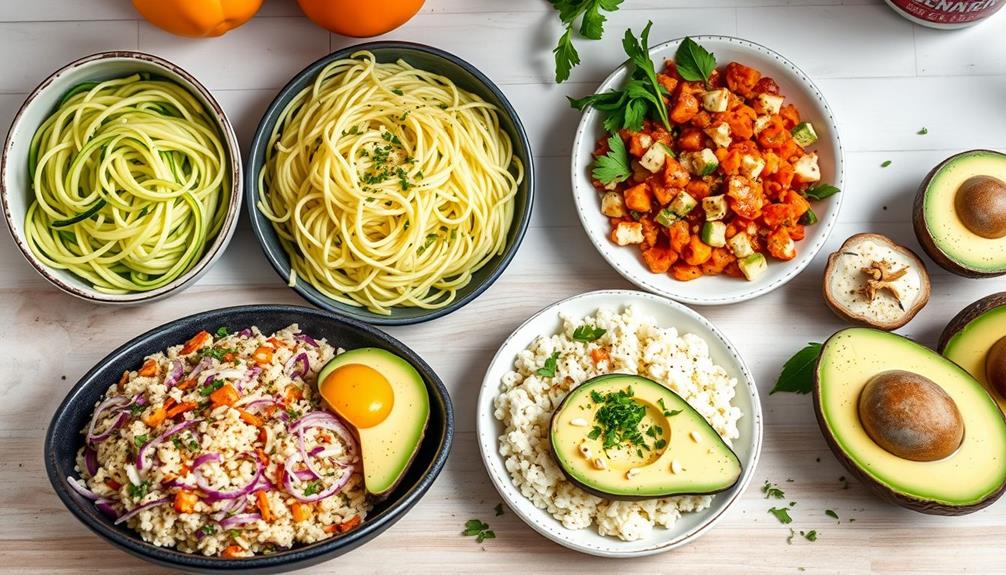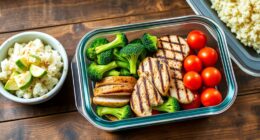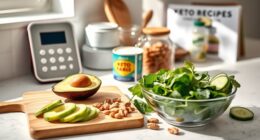With a well-stocked pantry, you can quickly create a variety of meals using staples like pasta, rice, canned tomatoes, chickpeas, and spices. By organizing your ingredients and knowing versatile recipes, you’ll be able to improvise and adapt dishes based on what’s available. This approach saves time, reduces waste, and keeps meal prep simple and creative. Keep exploring your pantry’s potential, and you’ll discover even more delicious options to enjoy every day.
Key Takeaways
- Use versatile pantry staples like pasta, rice, and canned beans to create quick, customizable meals such as stir-fries and casseroles.
- Combine canned tomatoes, spices, and grains for easy soups, stews, or pasta sauces with minimal prep.
- Incorporate dried herbs and spices as flavor boosters for simple dishes from your pantry items.
- Substitute ingredients creatively, like using chickpeas for hummus or canned vegetables in fried rice.
- Organize your pantry to quickly identify available ingredients and plan meals around what you already have.

Having a well-stocked pantry makes meal prep much easier and more efficient. When you keep a variety of staples on hand, you’re better equipped to whip up meals without last-minute runs to the store. This approach not only saves time but also minimizes food waste, as you can customize dishes based on what’s available. To get the most out of your pantry, consider exploring recipe alternatives that make use of what you already have. For example, if a recipe calls for fresh herbs, dried herbs can often work just as well. If you’re out of a specific spice, look for a substitute that complements the dish. This flexibility allows you to adapt recipes on the fly, keeping meal prep simple and stress-free.
A well-stocked pantry enables quick, flexible, and waste-free meal prep with versatile ingredient substitutions.
Proper storage tips are essential to keep your pantry staples fresh and accessible. Store dry goods like rice, pasta, and beans in airtight containers to prevent moisture and pests from getting in. Label everything clearly so you can easily identify ingredients and track expiration dates. Keep heavier items on lower shelves for stability, and lighter items up top. Consider grouping similar items together, such as canned goods or baking supplies, to streamline your prep process. Regularly check your stock to discard expired items and replenish what’s running low. This habit ensures you always have essentials on hand, reducing the need for last-minute shopping trips. Additionally, understanding the storage requirements for self-watering plant pots can help keep your gardening supplies organized and functional. Incorporating proper storage techniques for pantry items can also extend their shelf life and maintain quality, which is essential for an efficient meal prep routine.
When planning your meals, think creatively about how to combine ingredients from your pantry. For instance, a can of chickpeas can become the base for a quick hummus or added to a vegetable stir-fry. Canned tomatoes can serve as the foundation for pasta sauces, soups, or stews. Dried pasta and rice are versatile staples that work with a variety of flavor profiles. By understanding the potential of your pantry items, you can develop a repertoire of go-to meals that are quick to prepare. Keep a list of favorite recipes that utilize what you typically stock, so you’re never stuck staring at an empty fridge with no ideas.
Incorporating recipe alternatives into your meal prep routine makes your cooking more adaptable and less dependent on specific ingredients. When you’re familiar with different ways to use pantry staples, you’ll find it easier to improvise and create delicious dishes on short notice. Coupled with good storage tips, this approach turns your pantry into a powerhouse of meal potential, allowing you to craft satisfying, nutritious meals from what you already have on hand.
Frequently Asked Questions
How Long Do Pantry Meal Prep Leftovers Typically Last?
Leftovers from pantry meal prep usually last 3 to 4 days in the fridge. You should check storage duration and watch for spoilage indicators like sour smell, slimy texture, or mold. To maximize freshness, store leftovers in airtight containers and label them with dates. If you’re unsure, it’s safer to discard leftovers after the recommended time to avoid foodborne illness. Proper storage helps keep your meals safe and tasty longer.
Can I Safely Mix Canned and Fresh Ingredients in One Meal?
You can safely mix canned and fresh ingredients in one meal as long as you consider ingredient safety and flavor compatibility. Confirm canned items are properly drained and checked for bulging or leaks to prevent contamination. Taste test the combination to see if flavors work well together, and cook everything thoroughly. Combining these ingredients can be convenient and tasty, just be mindful of freshness and proper handling to keep your meal safe and delicious.
What Are Creative Ways to Use Expired Pantry Items?
Ever wondered how to use expired pantry items creatively? Don’t toss them out just yet! You can turn expired spices into potpourri or use dried herbs as fragrant storage solutions. For canned goods past their prime, creative substitutions like adding vinegar or lemon juice can boost flavor. Just remember, some items are better discarded. Are you ready to experiment with your pantry and turn leftovers into delicious, resourceful meals?
How Do I Prevent Boredom With Limited Pantry Ingredients?
To prevent boredom with limited pantry ingredients, you should focus on snack variety and flavor experimentation. Mix and match what you have to create new combinations, like adding spices or herbs for different tastes. Explore different cooking methods, like roasting or sautéing, to change textures. Keep things interesting by trying small, creative tweaks, and don’t be afraid to combine unlikely ingredients for exciting new flavors.
Are There Dietary Restrictions to Consider With Pantry Staples?
You might think pantry staples are universally suitable, but consider dietary restrictions like gluten sensitivities or vegan needs. Gluten sensitivities require avoiding wheat, barley, and rye, while vegans skip animal products. To accommodate these, explore gluten-free grains like rice or quinoa, and use plant-based substitutes such as beans, lentils, or tofu. Adjusting your pantry with these options guarantees you can prepare meals that respect everyone’s dietary needs.
Conclusion
Now that you know how to turn pantry staples into tasty meals, will you let your pantry be your secret weapon in busy times? With a little creativity and some basic ingredients, you can whip up satisfying dishes anytime. Remember, it’s not about having perfect ingredients, but making the most of what you have. So next time you’re unsure what to cook, ask yourself: aren’t the best meals often born from what’s already in your kitchen?









